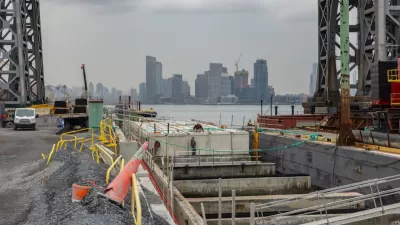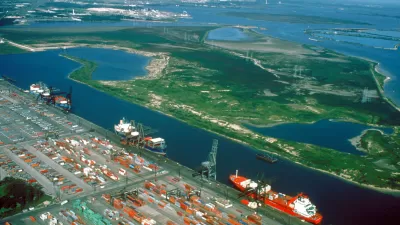While cities race to protect their subway infrastructure from more intense flooding, some experts argue that more investment is needed in more resilient street-level infrastructure.

"Subway systems around the world are struggling to adapt to an era of extreme weather brought on by climate change," write Hiroko Tabuchi and John Schwartz. "Their designs, many based on the expectations of another era, are being overwhelmed, and investment in upgrades could be squeezed by a drop in ridership brought on by the pandemic." In cities around the world, aging subway systems are being overwhelmed by worsening floods. "In New York, the Metropolitan Transportation Authority has invested $2.6 billion in resiliency projects since Hurricane Sandy swamped the city’s subway system in 2012, including fortifying 3,500 subway vents, staircases and elevator shafts against flooding."
Yet some experts argue that protecting subways may be a misguided approach. "With more extreme flooding down the line, protecting subways all of the time will be impossible, they say. Instead, investment is needed in buses and bike lanes that can serve as alternative modes of public transportation when subways are flooded. Natural defenses could also provide relief. Rotterdam in the Netherlands has grown plants along its tramways, enabling rainwater to be soaked up by the soil, and reducing heat." Bernardo Baranda Sepúlveda, a Mexico City-based researcher at the Institute for Transportation and Development Policy, says that "[s]treet-level light rail, bus systems and bicycle lanes aren’t just less exposed to flooding, they are also cheaper to build and easier to access."
FULL STORY: Climate Crisis Turns World’s Subways Into Flood Zones

Study: Maui’s Plan to Convert Vacation Rentals to Long-Term Housing Could Cause Nearly $1 Billion Economic Loss
The plan would reduce visitor accommodation by 25,% resulting in 1,900 jobs lost.

Alabama: Trump Terminates Settlements for Black Communities Harmed By Raw Sewage
Trump deemed the landmark civil rights agreement “illegal DEI and environmental justice policy.”

Why Should We Subsidize Public Transportation?
Many public transit agencies face financial stress due to rising costs, declining fare revenue, and declining subsidies. Transit advocates must provide a strong business case for increasing public transit funding.

Paris Bike Boom Leads to Steep Drop in Air Pollution
The French city’s air quality has improved dramatically in the past 20 years, coinciding with a growth in cycling.

Why Housing Costs More to Build in California Than in Texas
Hard costs like labor and materials combined with ‘soft’ costs such as permitting make building in the San Francisco Bay Area almost three times as costly as in Texas cities.

San Diego County Sees a Rise in Urban Coyotes
San Diego County experiences a rise in urban coyotes, as sightings become prevalent throughout its urban neighbourhoods and surrounding areas.
Urban Design for Planners 1: Software Tools
This six-course series explores essential urban design concepts using open source software and equips planners with the tools they need to participate fully in the urban design process.
Planning for Universal Design
Learn the tools for implementing Universal Design in planning regulations.
Smith Gee Studio
Alamo Area Metropolitan Planning Organization
City of Santa Clarita
Institute for Housing and Urban Development Studies (IHS)
City of Grandview
Harvard GSD Executive Education
Toledo-Lucas County Plan Commissions
Salt Lake City
NYU Wagner Graduate School of Public Service





























